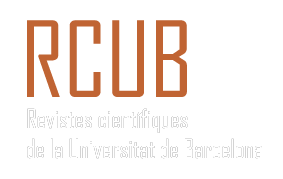The epichoric alphabet of Syracuse: origins and first testimonies
DOI:
https://doi.org/10.1344/AFAM2024.14.4Keywords:
epigraphy, red alphabet, blue alphabet, Sicily, writingAbstract
From the city of Syracuse, a colony of the Dorian Corinth, there are preserved inscriptions from the archaic period that show that the city used a different alphabet from that of its metropolis. In this paper we set out the characteristics of these scriptures and we describe the evolution of Syracusan alphabet from the earliest inscriptions, as well as we analyze the possible reasons why this change took place.
References
Albanese Procelli, Rosa Maria (1982), «Calderoni bronzei ad orlo orizzontale interno da Siracusa», Bollettino d’Arte, LXVII(15), 53-60.
Arena, Renato (1999), Iscrizioni greche arcaiche di Sicilia e Magna Grecia. Vol. 5. Iscrizioni di Taranto, Locri Epizefiri, Velia e Siracusa, Milà, Edizioni dell’Orso.
Astoreca, Natalia Elvira (2021), Early Greek alphabetic writing. A linguistic approach, Oxford/Filadèlfia, Oxbow.
Boehring, Eric (1929), Die Münzen von Syrakus, Berlín, Walter de Gruyter.
Brugnone, Antonietta (1995), «Gli alfabeti arcaici delle poleis siceliote e l’introduzione dell’alfabeto milesio», Annali Della Scuola Normale Superiore Di Pisa, 25(4), 1297-327.
Carpenter, Rhys (1945), «The Alphabet in Italy», American Journal of Archaeology, 49(4), 452-464.
Dubois, Laurent (1989), Inscriptions grecques dialectales de Sicile. Contribution à l’étude du vocabulaire grec colonial, París/Roma, École Française de Rome, Palais Farnèse.
Engelmann, Ηelmut (1981), «Die Bauinschrift am Apollonion von Syrakus», Zeitschrift Für Papyrologie Und Epigraphik, 44, 91-94.
Forrer, Leonard & Weber, Hermann (1922), The Weber collection, Vol. 1: Greek coins; Auriol Find Class, Hispania, Gallia, Britannia, Italy and Sicily, Londres, London Spink & Son.
Guarducci, Margherita (1949), «Note di epigrafia siceliota arcaica», Annuario della Scuola Archeologica di Atene e delle Missioni Italiane in Oriente, 27-29, 103-16.
Guarducci, Margherita (1967), Epigrafia greca I. Caratteri e storia della disciplina. La scrittura greca dalle origina all’età imperiale, Roma, Istituto Poligrafico dello Stato.
Guarducci, Margherita (1986), «Epigrafi arcaiche di Siracusa e di Megara Iblea», Archeologia Classica, 38(40), 1-26.
Head, Barclay Vincent (1874), «On the chronological sequence of the coins of Syracuse», The Numismatic Chronicle and Journal of the Numismatic Society, 14, 1-80.
Head, Barclay Vincent (1911), Historia numorum, a manual of Greek numismatics, Oxford, Clarendon Press.
Jeffery, Lilian Hamilton (1961), The Local Scripts of Archaic Greece. A Study of the Origin of the Greek Alphabet and its Development from the Eighth to the Fifth Centuries. B.C., Oxford, Clarendon Press.
Johnston, Alan W. (1975), «Sicilian Notes: [unrepresentable symbols] and the Date of the Demareteion», Zeitschrift für Papyrologie und Epigraphik, 17, 153-156.
Johnston, Alan W. (1990), «Supplement» a Jeffery, L. H. (1961), The Local Scripts of Archaic Greece. A Study of the Origin of the Greek Alphabet and its Development from the Eighth to the Fifth Centuries. B.C., Oxford, Clarendon Press.
Knoepfler, Denis (1992), «La chronologie du monnayage de Syracuse sous les Deinoménides: Nouvelles données et critères méconnus», Schweizerische Numismatische Rundschau, 71, 5-46.
Kraay, Colin M. (1972), «The Demareteion Reconsidered: A Reply», The Numismatic Chronicle (1966-), 12, 13-24.
Langlotz, Ernst (1972), «Importazione di ceramica greca ovvero immigrazione di vasai greci nella Magna Grecia?», en Economia e società nella Magna Grecia. Atti del dodicesimo convegno di studi sulla Magna Grecia, Taranto, 8-14 ottobre 1972, Braudel, Fernand (ed.), Nàpols, L’arte tipografica, pp. 163-183.
Lewis, Virginia M. (2019), «Two Sides of the Same Coin: The Ideology of Gelon’s Innovative Syracusan Tetradrachm», Greek, Roman and Byzantine Studies, 59, 179-201.
Mimbrera, Susana (2012), «Sicilian Greek before the fourth century BC: An overview of the dialects», en So many Sicilies: Introducing language and linguistic contact in ancient Sicily, Tribulato, Olga (ed.), Nova York, Cambridge University Press, pp. 191-222.
Rizzo, Giulio Emanuele (1946), Monete greche della Sicilia, Roma, La libreria dello stato.
Stazio, Attilio (1963), «La documentazione numismatica in Metropoli e colonie di Magna Grecia», en Metropoli e colonie di Magna Grecia. Atti del terzo convegno di studi sulla Magna Grecia tenuto a Taranto dal 13 al 17 ottobre, Romanelli, Pietro (ed.), Nàpols, L’arte tipografica, pp. 113-132.
Toscanelli, Nello (1914), Le origini italiche Vol. I. La literatura Lib. I. Le lingue e le scritture esotiche dell’Italia antichissima dal vii al iii secolo a.C., Milà, Ulrico Hoeplo.
Voutiras, Emmanuel (2007), «The Introduction of the Alphabet», en A History of Ancient Greek: From the Beginnings to Late Antiquity, Christidis, Anastasios-Foivos (ed.), Cambridge, Cambridge University Press, pp. 266-276.
Woodard, Roger D. (2014), The textualization of the Greek Alphabet, Nova York, Cambridge University Press.
Woodward, Arthur M. et al. (1908), «Laconia: I.-Excavations at Sparta, 1908 §5.-Inscriptions», The Annual of the British School at Athens, 14, 1-160.
Downloads
Published
How to Cite
Issue
Section
License
Copyright (c) 2024 Maria Navarro

This work is licensed under a Creative Commons Attribution-NonCommercial-NoDerivatives 4.0 International License.
The authors who publish in this journal agree to the following terms:
a. Authors retain copyright and grant the journal the right of first publication.
b. Texts will be published under a Creative Commons Attribution License that allows others to share the work, provided they include an acknowledgement of the work’s authorship, its initial publication in this journal and the terms of the license.
Submission and processing charges: AFAM does not have either article submission charges or article processing charges (APCs)






